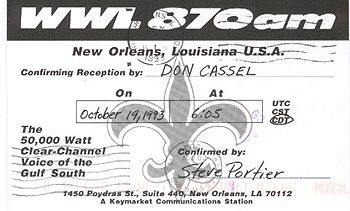Sending MW Reception Reports
One of the more satisfying aspects of DXing is collecting QSL cards and letters from stations you have heard. QSLing these stations involves writing an accurate reception report of a station you have heard, mailing it to the station, and waiting for a reply. It sounds easy enough, and it is, but some techniques can help to improve your success rate.
Creating an Accurate Reception Report
What station engineers and other personnel are interested in, is whether you have heard their station. And to prove this successfully you need to send an accurate report. After all, receiving a report for a different station does the one who receives it little good.
To begin, you need to record the frequency, date and time when the station was heard. For medium wave stations, time should be given for the zone where the station is located. Thus if you are receiving stations in the eastern zone, such as Ontario and New York, use EST or EDT depending on the time of year. Stations, in the central zone, such as Chicago, IL use CST or CDT which is one hour earlier than eastern time. If you're not sure then clearly indicate your local time.
Now, as you are listening, jot down some details of the program. Look for some of the following items when listening to the program:
- The way the station identifies itself.
- The name of the program.
- Names of station personalities, such as a talk show host.
- Commercials. These are always good indicators because the station needs to keep track of commercials they run.
- Names of special items such as CNN news or TSN sports.
The point of this information is to demonstrate to the station that you actually heard their program. Usually the more detail the better. Of course, how much detail you can record often depends on reception conditions. But you will need some accurate detail if you expect to receive a QSL confirmation.
Also include some indication of how well the signal was received. Shortwave reports use the SINPO code but for medium wave something simpler will usually suffice. Try using the following in your reports:
Excellent.
Use when the signal is strong and there is virtually no interference.
- Good.
This indicates that you could hear the station okay but maybe there was some interference, noise or fading.
- Fair.
There was interference, and/or, fading or noise making copy difficult but you could still understand parts of the program. Enough for a positive identification.
- Poor.
It was almost impossible to copy the signal but you could hear some content. Enough to make a tentative identification.
To find the address of the station you will need one of the references given in the Medium Wave Resources section. Finding the address can be done at your leisure and need not take up valuable DXing time. The following form shows a sample reception report prepared for 870 WWL in New Orleans. Notice that although the listener lives in the Eastern time zone the report used Central time which is the time in use at the station.
Reception Report |
|||
| WWL New
Orleans 1450 Poydras Ave. Suite 440 New Orleans, LA 70112 |
|||
| Date(dd/mm/yy): | Time: | Frequency: | Signal: |
| 19/10/93 | 0605 CDT | 870 | Good |
| Program Content | |||
| At 6:05
AM CDT (7:05 AM EDT) the News was in progress. Station ID was given as "WWL news time 6:09." A Forms Control Company commercial. The news continued. Station ID given as "WWL 870 AM" followed by a Campo commercial for Sony Trinitron. |
|||
This report resulted in the author receiving the following QSL card from WWL.
What Else to Send
Now that you have all of the information needed for the report, you will want to create an attractive report to send. You might type up a form, such as the one shown here and then make copies of it so you can fill in the details. If you have a computer use your word processor. Some SWLers use a postcard which can also be effective. Of course you'll need to include your name and address if you expect a reply. Also a personal note about how you enjoyed the program can help.
Finally, when you send reports to smaller stations or public broadcasting stations a reply may be more likely if you provide the postage. Reports to Ontario stations could include standard letter postage in the form of a stamp. U.S. stations appreciate a U.S. stamp for mailing to Canada, currently 52 cents or a green stamp (a U.S. dollar). Don't send Canadian stamps to the U.S. and don't send a Loonie.
What to Expect in Return
If you send an accurate and complete report then within a few weeks, sometimes months, you can expect to receive either a QSL card or a confirmation on the station letterhead. Some stations will even send a bumper sticker or other memorabilia. You never know. Some stations never respond, other do only after a follow-up report. But be patient. Station people, like the rest of us, are busy so give them a reasonable amount of time. After a season of MW DXing you will have a nice collection of QSL's as your reward for persistent listening.
Text © 1999 Don
Cassel VE3BUC
You can e-mail me at ve3buc@rac.ca


